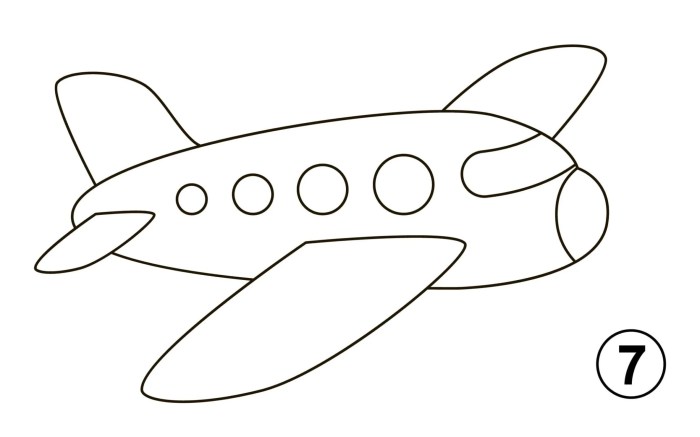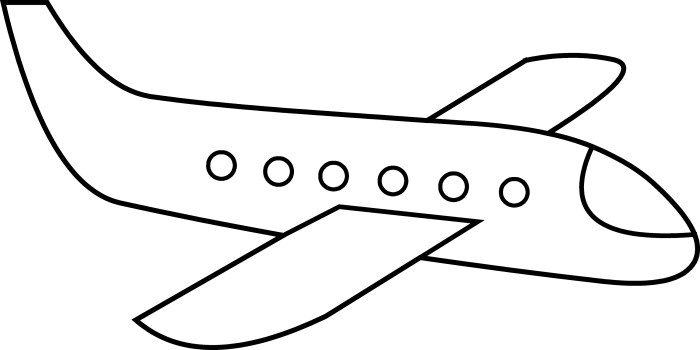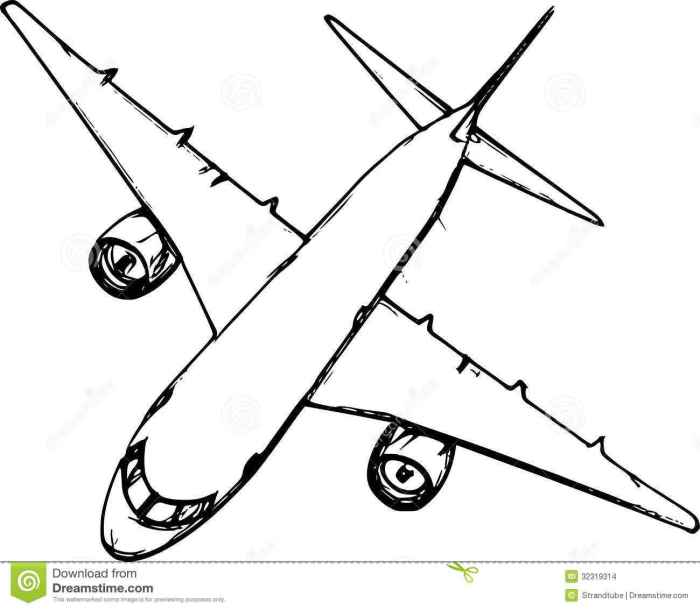Basic Shapes & Structures

Easy drawing of aeroplane – Aduh, drawing a plane? Easy peasy, lemon squeezy! Even a monyet (monkey) could do it with a little guidance, eh? We’ll break it down into simple shapes, so you can make a pesawat (airplane) that’s way cooler than your temen’s (friend’s). Think of it as building with LEGOs, but on paper.
We’re gonna use basic shapes to build our cartoon plane. It’s all about simplifying things, making it easy to draw, even if you’re a newbie. No need for fancy shading or intricate details – just the core shapes and a bit of imagination. Think of it as a super simplified version, a “basic” plane, if you will.
A Simple Aeroplane Using Four Basic Shapes
Alright, let’s get this show on the road! We’ll build our awesome cartoon plane using only four shapes: a rectangle, a square, and two triangles.
The simplicity of an airplane drawing, often reduced to basic geometric shapes, belies the complex engineering beneath. This ease of representation contrasts with the seemingly more organic challenge of subjects like animals; consider, for instance, the subtleties involved in an easy drawing of a cow , requiring careful observation of curves and proportions. Returning to the airplane, even the most rudimentary sketch can convey a sense of flight and movement, highlighting the power of simplification in artistic expression.
Step 1: The Body (Rectangle): Draw a long rectangle. This is the main body of our plane, the fuselage, you know, where the passengers sit. Make it a bit longer than it is wide.
Step 2: The Wings (Triangles): Now, attach two triangles to the top of the rectangle. These are the wings! Make sure they’re symmetrical (the same size and shape on both sides). They should stick out from the sides of the rectangle.
Step 3: The Tail (Square): Draw a small square at the back of the rectangle. This is the tail. It helps to keep the plane stable in the air.
Step 4: The Propeller (Circle): Finally, draw a circle at the front of the rectangle. This is the propeller! It spins around and makes the plane fly. You can add smaller circles inside the main circle to give it more detail, if you want.
And there you have it! A super simple, super cute cartoon aeroplane, made entirely from basic shapes. Gampang banget, kan? (Very easy, right?)
Perspective and Simple Aeroplane Drawings
Perspective is all about how things look depending on where you’re standing. If you’re looking at a plane head-on, it’ll look different than if you’re looking at it from the side or above. With our simple shapes, this is easy to show.
For example, if you draw the wings slightly smaller and angled upwards as they go further away from you, it gives the impression of depth and makes the plane look more three-dimensional. Similarly, the tail might appear smaller if it’s further away from the viewer. It’s about showing the difference in size of the shapes to create that sense of distance.
It’s like a magic trick, but with shapes!
Comparing Shapes for Aeroplane Parts
| Aeroplane Part | Shape | Alternative Shape | Notes |
|---|---|---|---|
| Fuselage (Body) | Rectangle | Long Cylinder (approximated with multiple rectangles) | A rectangle is the simplest representation. A cylinder is more realistic but harder to draw simply. |
| Wings | Triangles | Trapezoids | Triangles are easy; trapezoids give a slightly more accurate shape. |
| Tail | Square | Triangle | A square is simple; a triangle might represent a more streamlined design. |
| Propeller | Circle | Multiple overlapping circles | A single circle is sufficient for a cartoon style. Overlapping circles can add detail. |
Adding Details & Enhancing the Drawing: Easy Drawing Of Aeroplane

Euy, so you’ve got your basic aeroplane shape down, eh? Now it’s time to
- upgrade* it from “meh” to “mantap”! We’re talking about adding those little details that make all the difference, turning a simple sketch into a real head-turner. Think of it as adding the
- bumbu* (spices) to your culinary masterpiece, making it truly unforgettable.
Shading and Highlights
Adding shading and highlights is like giving your aeroplane a proper
makeover*. It brings out the form and depth, making it look three-dimensional instead of flat. Imagine a sunny day
the top of the plane would be brighter, while the underside would be darker. Use lighter shades for the areas facing the light source (your highlight), and darker shades for the areas facing away (your shadow). You can achieve this using pencils of varying darkness, or even by smudging your pencil strokes for a softer effect. Think about where the light is coming from – is it the sun, a spotlight?
This will determine the placement of your highlights and shadows. For instance, a strong light source will create sharp, defined shadows, while a softer light will create gentler, more diffused shadows.
Adding Texture to the Aeroplane’s Surface
Nah, a plane isn’t just a smooth surface, is it? It has rivets, panels, maybe even some wear and tear. To make it look more realistic, add some texture! You can achieve this by using different techniques. For example, for a metallic look, you can use short, hatched lines to simulate the reflection of light off a metal surface.
For a rougher texture, you might use cross-hatching or stippling (tiny dots) to suggest the plane’s material. Think about the different parts of the plane – the fuselage might be smooth, while the wings might have more texture. Don’t be afraid to experiment! The key is to add subtle variations in tone and texture to give your drawing more life.
Creating a Background that Complements the Aeroplane Drawing, Easy drawing of aeroplane
A killer background can make or break your drawing, you know. A simple, uninspired background can make your awesome aeroplane look…well, a bit lonely. But a well-chosen background can really elevate the whole piece. You could choose a vibrant blue sky, a bustling airport scene, or even a dramatic sunset. The choice is yours, depending on the mood you want to create.
Remember, keep it simple; don’t overcomplicate things.
A Simple Background Scene: Airport at Sunset
Let’s design a simple airport scene at sunset. Start with a large rectangle for the ground, using a light orange for the sunset glow. Add a few smaller rectangles for buildings – maybe a control tower and a hangar. Use darker shades of orange and brown for these buildings. For the sky, use a gradient of oranges, reds, and purples, getting darker towards the top.
Add some simple, slightly curved lines to suggest distant hills or mountains on the horizon. You can add small, simple shapes for trees or other elements to enrich the scene. Remember, less is more. This simple background will create a pleasing contrast with your aeroplane drawing and provide context for the image. It’s all about creating a harmonious blend between the plane and its surroundings.
Creating Variations & Exploring Styles

Euy, udah bisa gambar pesawat sederhana? Keren! Sekarang kita naikin levelnya, aje gile! Kita bakal eksplorasi berbagai gaya dan sudut pandang gambar pesawat, biar nggak monoton, cuy. Siap-siap meledak-ledak kreativitasnya!Different angles and artistic styles add a whole new dimension to your drawings, making them way more interesting. Think of it like this: a simple plane drawing is like a basic nasi uduk, but with variations, it becomes nasi uduk with rendang, sate, or even a crazy fusion dish! So let’s get cooking!
Aeroplane Drawings from Different Angles
Gambar pesawat dari berbagai sudut pandang itu penting banget, biar keliatan lebih realistis dan dinamis. Bayangin aja, kalo cuma gambar dari samping terus, bosen juga kan? Nah, coba deh gambar dari depan, samping, dan atas. Dari depan, kamu bakal fokus ke bagian kokpit dan baling-baling (kalo ada). Dari samping, kamu bisa nunjukin bentuk badan pesawat secara keseluruhan.
Terus dari atas, kamu bisa liat bentuk sayap dan ekornya. Gampang banget, kok! Coba deh praktek langsung, pasti seru!
Variations in Artistic Style
Nah, ini dia bagian yang asyiknya! Kamu bisa ubah gaya gambar pesawatmu. Mau gaya kartun yang lucu dan gemesin? Gampang banget! Tinggal bikin bentuknya lebih bulat, mata gede, dan senyum lebar. Atau, kalo mau yang realistis, perhatiin detailnya lebih teliti, kayak tekstur logam, bayangan, dan detail mesin. Atau, kalo kamu suka yang abstrak, coba deh bereksperimen dengan bentuk-bentuk geometri, warna-warna berani, dan garis-garis dinamis.
Pokoknya, asalkan kamu suka dan kreatif, pasti hasilnya keren abis! Misalnya, pesawat kartun bisa punya badan gemuk dan mata melotot, sementara pesawat realistis bisa detail banget sampai ke baut-bautnya. Pesawat abstrak? Bisa jadi sekumpulan garis dan warna yang membentuk siluet pesawat.
Incorporating Colors and Patterns
Warna dan pola itu kayak bumbu dapur, cuy! Bisa bikin gambarmu jadi lebih hidup dan menarik. Kamu bisa pake warna-warna cerah dan kontras untuk gambar kartun, atau warna-warna metalik dan gelap untuk gambar realistis. Atau, coba deh pake pola-pola unik, kayak polkadot, garis-garis, atau bahkan motif batik! Jangan takut bereksperimen, asalkan warnanya pas dan nggak tabrakan, pasti hasilnya oke punya! Bayangin pesawat dengan livery batik, atau pesawat kartun dengan warna pelangi, pasti unik banget!
Adding Creative Elements
Nah, ini dia puncaknya! Kamu bisa tambahin elemen-elemen kreatif lain ke gambar pesawatmu. Mau gambar awan, burung yang terbang di sekitarnya, atau jejak asap di langit? Silakan! Kamu juga bisa tambahin latar belakang yang keren, kayak pemandangan kota, pegunungan, atau bahkan luar angkasa! Pokoknya, asalkan sesuai dengan imajinasimu, pasti hasilnya bakal cetar membahana! Coba bayangkan pesawat terbang di atas gunung yang bersalju, atau pesawat yang meninggalkan jejak bintang di langit malam.
Asyik banget, kan?
FAQs
What materials do I need to draw an aeroplane?
You’ll primarily need paper and a pencil. Colored pencils, crayons, or markers can add vibrancy to your drawings.
How can I improve my aeroplane drawings?
Practice regularly, study real aeroplanes for reference, and experiment with different perspectives and shading techniques.
What if my aeroplane drawing doesn’t look perfect?
Don’t worry! Art is about expression, not perfection. Embrace imperfections as part of your unique style.
Are there any online resources to help me learn more?
Yes! Many websites and YouTube channels offer free tutorials and drawing lessons.
